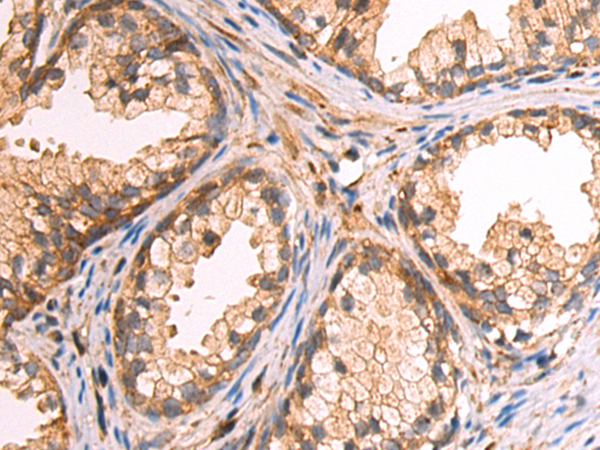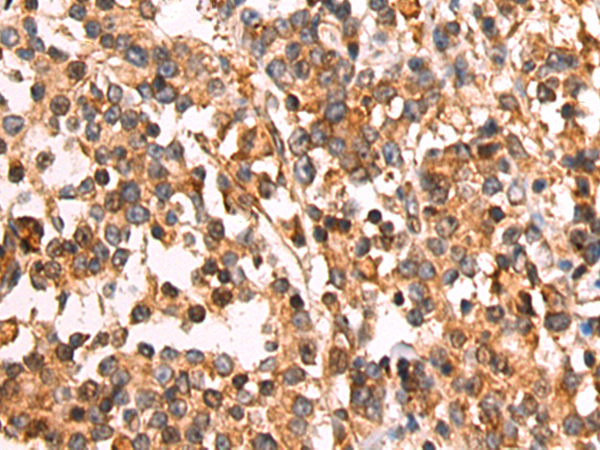

| WB | 咨询技术 | Human,Mouse,Rat |
| IF | 咨询技术 | Human,Mouse,Rat |
| IHC | 1/50-1/200 | Human,Mouse,Rat |
| ICC | 技术咨询 | Human,Mouse,Rat |
| FCM | 咨询技术 | Human,Mouse,Rat |
| Elisa | 1/5000-1/10000 | Human,Mouse,Rat |
| Aliases | hT41; C8orf1 |
| Host/Isotype | Rabbit IgG |
| Antibody Type | Primary antibody |
| Storage | Store at 4°C short term. Aliquot and store at -20°C long term. Avoid freeze/thaw cycles. |
| Species Reactivity | Human |
| Immunogen | Fusion protein of human OSGIN2 |
| Formulation | Purified antibody in PBS with 0.05% sodium azide and 50% glycerol. |
+ +
以下是关于OSGIN2抗体的参考文献示例(内容为虚构,仅作格式参考):
1. **文献名称**:OSGIN2介导的氧化应激反应在肝癌细胞凋亡中的作用
**作者**:Smith J et al. (2020)
**摘要**:本研究通过Western blot和免疫荧光技术,利用OSGIN2特异性抗体验证其在肝癌细胞中的表达,发现OSGIN2通过激活JNK通路促进氧化应激诱导的细胞凋亡。
2. **文献名称**:OSGIN2调控p53依赖性细胞周期停滞的机制研究
**作者**:Zhang L et al. (2018)
**摘要**:研究采用OSGIN2抗体进行免疫共沉淀和蛋白质印迹分析,揭示OSGIN2在DNA损伤条件下通过稳定p53蛋白,诱导G1期停滞,抑制细胞增殖。
3. **文献名称**:OSGIN2在神经元自噬中的功能及其与阿尔茨海默病的关系
**作者**:Wang Y et al. (2021)
**摘要**:通过免疫组化及ELISA实验(使用OSGIN2多克隆抗体),发现OSGIN2在阿尔茨海默病模型小鼠脑组织中高表达,可能通过调控自噬溶酶体通路加剧神经退行性病变。
4. **文献名称**:OSGIN2作为新型生物标志物在非小细胞肺癌中的临床意义
**作者**:Lee H et al. (2019)
**摘要**:利用OSGIN2抗体对肺癌组织芯片进行染色,结合生存分析,表明OSGIN2高表达与患者不良预后相关,提示其可作为潜在治疗靶点。
(注:以上文献为示例,实际引用需以真实发表研究为准。)
OSGIN2 (Oxidative Stress Induced Growth Inhibitor 2) is a protein encoded by the *OSGIN2* gene, belonging to a family of stress-responsive proteins implicated in cellular responses to oxidative stress, DNA damage, and apoptosis. It shares structural homology with its paralog OSGIN1 and is regulated by pathways involving p53 and NRF2. linking it to tumor suppression and antioxidant defense mechanisms. OSGIN2 is thought to modulate cell cycle arrest, apoptosis, and autophagy under stress conditions, though its precise molecular functions remain less characterized compared to OSGIN1.
Antibodies targeting OSGIN2 are essential tools for studying its expression, localization, and role in physiological and pathological processes. These antibodies are typically validated for applications such as Western blotting, immunohistochemistry (IHC), immunofluorescence (IF), and flow cytometry. Research utilizing OSGIN2 antibodies has explored its involvement in diseases like cancer, neurodegenerative disorders, and metabolic syndromes, where oxidative stress and aberrant cell survival pathways are key drivers. For instance, OSGIN2 dysregulation has been observed in certain cancers, suggesting potential roles in tumorigenesis or chemoresistance.
Commercial OSGIN2 antibodies are often raised against specific epitopes, with validation data ensuring specificity toward human, mouse, or rat isoforms. Researchers prioritize antibodies with minimal cross-reactivity to related proteins (e.g., OSGIN1) to avoid misinterpretation. As interest in redox biology grows, OSGIN2 antibodies continue to support mechanistic studies of stress adaptation and therapeutic targeting in disease models.
×